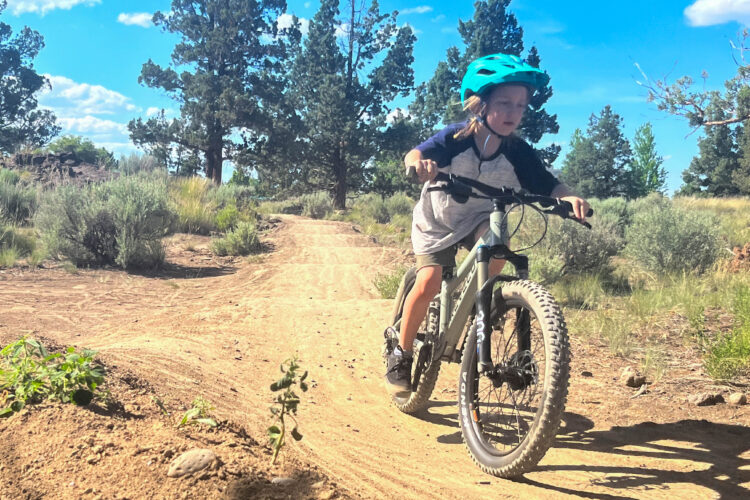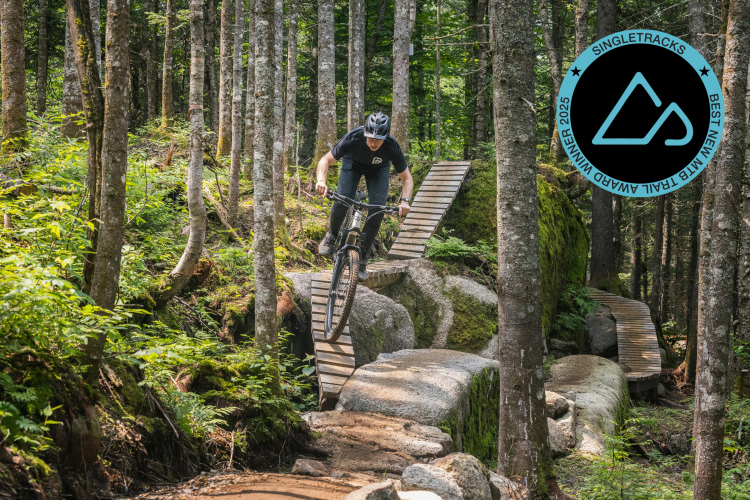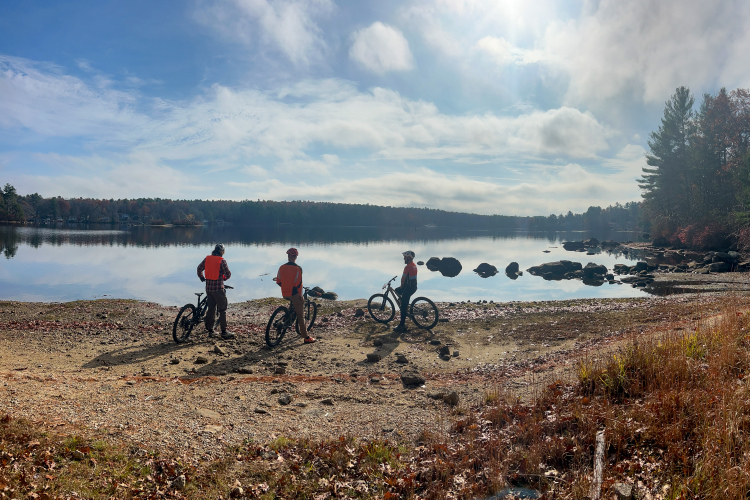
Since I started seriously riding bikes 25 years ago, I have broken my shoulder blade, index finger, numerous ribs, and something called a coracoid process. I have also bruised my lung and tailbone, sprained my shoulder and wrist, and have enough road rash on my hips, elbows, and shoulders to garner looks when I go swimming. My shins look like I kicked a barbed wire fence.
With injuries on my mind, I bought my son, Aksel, a bike for his first birthday. I set up his shiny blue Strider Balance Bike on its rocker base and, after eating cake, helped him climb on. Within minutes, he was rocking so fast that I had second thoughts about putting him on a bike so soon and placed my hand on the back of the bike to make sure he didn’t flip over. When I removed my hand, Aksel rocked back up to speed, smiled, and shrieked with joy. My doubts disappeared.
I grew up on a quiet cul-de-sac, and from an early age had free reign to explore the neighborhood on my silver Mongoose. I watched the classic BMX movie Rad on rewind and spent a lot of time at the local bike shop, aptly named Mike the Bike, checking out number plates and handlebar grips that resembled those of Cru Jones. I didn’t get the BMX pants I desperately wanted for my 9th birthday, so I resorted to riding around in my brown winter gloves, in the heat of summer, because Cru wore gloves while riding. I left some skin and blood on Holly Lane, but watching my neighbor, Geoff Madden, break his leg after taking too much speed off a ramp in front of my house, is my first memory of a real biking injury.
I got my first mountain bike, a bright blue Trek 830, for my 13th birthday, but used it mainly for getting to the baseball field when I was in my teens and to classes when I lived off campus in college. During my senior year in college, I signed up for a few triathlons and quickly realized that the Trek wasn’t going to help me win any races. My mom surprised me with a chameleon-colored Cannondale R1000 road bike for an early graduation gift, not knowing that this purchase would change the direction of my life. I took a few falls at red lights and in the driveway while trying to figure out how clipless pedals worked but otherwise enjoyed my first real road rides during an unseasonably warm winter.
A year and a half later, I worked in a bike shop and got a deal on a dark blue Gary Fisher Sugar 4+, my first dual suspension mountain bike. Ten minutes into my first trail ride, I fell, landed on a tree stump, and broke a rib. I finished the ride, in bearable pain, and then spent the next four weeks struggling to sleep and take deep breaths. Those first ten minutes, though, were magical. With my best friends, Pedro and Ana, we rode through a festival of fall colors with streaks of sun shooting through openings in the dense canopy in the hills of Western Massachusetts. This was a far cry from the dreary hockey rinks where I spent most of my youth. I watched Pedro and Ana, who had been riding for years, skillfully send it down steep pitches peppered with rocks and roots that I was nervous about walking down, and fly down smooth stretches at speeds I associated with road biking. I was hurt but hooked.
I spent the next year in Utah and, after the snow melted, checked out the burgeoning trail networks in Park City and along the Wasatch Front. I also took a memorable week-long trip to the Utah desert and rode the famed slickrock in Gooseberry Mesa, just outside of Zion National Park. I chased after friends who had been riding for years and experienced going over the bars for the first time while also turning my hips perpetually purple. Navigating tricky rock gardens, flying through tight Aspen and Cottonwood forests at high speeds, and riding exposed trails provided an incredible rush that I never experienced when playing sports with rule books and painted lines.
In the spring of 2005, while training for my second Ironman, I preemptively hit the tarmac on a steep downhill to avoid T-boning a car that had made an abrupt turn across my lane. My bike snapped in half, and I skidded 20 feet down the road. I jumped up, full of adrenaline, and screamed at the driver about my broken bike and bloody body. I called a friend, and we loaded my busted bike and banged up body into his truck for a trip to the hospital. It wasn’t until I started walking into the ER that I realized I was only wearing one bike shoe. I peeked into the bed of my friend’s truck to see that my other shoe was still attached to the pedal.
I escaped without any broken bones, but the pain I endured when the nurse scrubbed my road rash with a rough sponge still makes me squirm. The doctors told me to take it easy for a few days, so I went to work the next day and visited the bike shop in the afternoon to order a new bike. When I got back home, my back muscles started spasming, as the doctors told me they would, and I collapsed onto my bed. I spent the next two days lying on the floor at my parents’ house requiring assistance to eat and use the bathroom. Three months and hundreds of miles of training rides later, I crossed the finish line in Lake Placid.
Over the next decade, I explored more trails in the Western US; the streets and parks in Brooklyn, New York; and, most memorably, the deserts in Jordan, where I taught at a boarding school on the outskirts of a small town just south of Amman. On weekends, my friends and I would ride down to the Dead Sea and enjoy heavenly views across the Levant. After a few rides on paved roads, we ventured off onto dirt tracks that weave through vast wadis teeming with incongruously lush vegetation and Bedouin camps that disappeared after the first rains in the fall and returned between rides in early spring. Upon reaching the Sea, we searched for shade and a ride back up to the top of the valley. We would then extract our bikes and selves from a flatbed, delivery van, or tiny Toyota and ride to a roadside fruit stand before sprinting back to campus to beat the crowds emerging from Friday prayers.
I also took some heavy falls. The most impressive, and painful, was back in Massachusetts where I went over the bars after hitting a pothole while taking a sip from my water bottle toward the end of a beautiful early spring road ride. My helmet and right shoulder, which still has a patch of skin a few shades lighter than the rest, took the brunt of the impact. I pedaled to my friends’ house in pain, dreading both the coming cleaning of my road rash and inability to turnover in bed without wincing for the next week. Two days later, I was out on my mountain bike, convinced that a light ride through the budding maples might ease my discomfort. It did.
A few months prior to Aksel’s birth, I was riding in Flims, Switzerland and followed a local rider off a kicker on the side of a trail. I wasn’t carrying enough speed, landed on a large root, and jackknifed over the bars. I spent the next few minutes stumbling around looking, and possibly sounding, like a bird who had just broken a wing after crashing into a window. I waved off the help from the local rider and rode gingerly back to the hotel thinking not about the pain, but about how my pregnant wife was going to react. When I showed her my shoulder, she shook her head and said, “that doesn’t look right.” It still doesn’t, thanks to a bony protrusion that sticks up half an inch off the top of my shoulder.
The local doctor took an x-ray and said that my shoulder blade looked broken. He recommended an MRI, but the nearest hospital was an hour away, so my wife and I went to dinner and a wine bar with our friends instead. After a few hours in the emergency room the next evening, I learned that I had indeed broken my shoulder blade and coracoid process, the hook-shaped bone that comes off the scapula and is, apparently, unusual to break. I spent the next six weeks in a sling followed by two months of focused rehab knowing that I wanted to be strong enough to hold my soon-to-be-born child.


After nine months of nightly rocking, I took Aksel’s bike off the rocker base and set him up at the top of the slight incline in our garden. He smiled and made some funny sounds as he shuffled about two meters before tossing the bike aside to inspect a nearby water drain. He did a few more laps in the yard before I brought him out to the driveway where he started lifting his feet off the ground for short spells and got to experience the joy of balancing on a bike. He couldn’t form sentences yet, but his shrieking showed his spirits. My smile showed mine. The snow soon forced us into the massive garage beneath our apartment house, but the fun didn’t stop. Aksel was soon weaving in and out of parked cars and support columns, screaming at the top of his lungs as he chased me, and riding down the small ramp leading to the garage’s lower level.
In early March, as the snow started to melt, we migrated back outside, where we often ended our rides in the large parking lot of the ski area in our town. The melting snow left plenty of puddles, and Aksel, wearing his favorite PAW Patrol cape or bear suit, made it his mission to find and ride through the deepest and dirtiest one. I often helped him locate it. He also enjoyed sending it down the steep walkway leading from the tram and then riding through a shallow gutter that would buck him in the air; I could hear his laugh from across the parking lot. One day I heard his scream. Just like his dad, Aksel got a bit too excited; he took too much heat into the gutter and crashed. He cut his lip and scraped his leg, so I cleaned him up and put him right back on his bike. A few minutes later, with tears still wet on his face, he walked his bike back up the ramp for another go.
Three months after Aksel’s first crash, I headed out for one of my favorite rides, the Urschner Höhenweg. The trail starts in Tiefenbach, about halfway up the famed Furka pass, and runs along the south-facing side of the Ursern Valley where I have unmatched views of several glaciers; the valley’s three mountain passes: the Gotthard, Oberalp, and Furka; and the many magnificent peaks that I ski off in winter. At the top of the last downhill section, I started fiddling with my backpack, lost control on a tight switchback, and went over the bars. I landed on a large boulder just off the trail and spent the next several minutes writhing on the ground while groaning and trying to take a breath. I knew that I had seriously injured myself and had to get off the mountain. I was experiencing a different type of adrenaline rush than I had headed out hoping to catch, but it did help me make it down to the clinic, where I was told I had broken a few ribs. I spent the next month sleeping in the sitting position and struggling to walk around the block. The worst part, though, was having to pause Aksel’s and my bike adventures.
Over the next year, I struggled with persistent back pain before finally visiting a rheumatologist. After a few weeks of needling, I had an MRI and then a CT scan, which showed a spot on my lung from when one of the broken ribs, now revealed to be between 5 and 8, hit it during my crash. I also learned that one of the broken ribs had not healed in the correct position and that the insistent pain was a result of pseudoarthrosis. Physical therapy, stretching, and an electro-stimulation device have helped to ease the pain, but the best remedy has been riding with Aksel.

Aksel now rides a 16-inch pedal bike, so we can explore farther from home. Our favorite rides last year were on trails running alongside two of the four largest rivers in Switzerland, the Reuss and Rhone. The Reuss ride starts on a dirt road in the neighboring town of Realp and weaves through cow, sheep, and goat fields dotted with glacial erratics, barns, and an old church, where we often light a candle and pray for the health of Aksel’s grandparents. Trying to pet the cows, all of whom Aksel has named Bettina, after Farmer Yumi’s cow in PAW Patrol, leads to lots of laughs, but his favorite part is the bobsled-like singletrack section that runs alongside the Reuss before diving into a grove of trees. Until it wasn’t. In early October, Aksel slid out on a small metal bridge that crosses a creek just in front of the grove. Before he even got off the ground, he picked up a handful of rocks and threw them at the bridge while shouting that he hated it. I soon realized he wasn’t mad that he had scraped his leg but that he wouldn’t be going fast enough when he entered the hallway-like trail through the trees.
The Rhone ride starts on a well-manicured bike path in the town of Oberwald, on the western side of the Furka pass, and keeps things interesting with a few speedy downhills and some singletrack along the river. When we stop for snacks along the way, I chart our progress on the map, study train schedules, and take stock of our food reserves to make sure we make it back home without any meltdowns. As I stress, Aksel munches on mangos or goldfish, looks across the valley, and says, “Dad, it’s beautiful here.” I put my phone away and take in the scenery realizing that we will be fine if we miss the next train. Ten kilometers from our starting point, we end up at a playground that abuts an old military airbase. After jumping on the trampoline, riding the zip-line, and more food, we pedal along the airfield to the train station and head home.

Riding with Aksel is pure pleasure, but I also enjoy simply watching as he pushes his limits. I was alarmed when Aksel told me he wanted to hit the big jump line on the dirt jump track in town, but I didn’t stop him. He sent it perfectly, and his holler challenged the reach of the local church bells. The next week, he took the drop with too much speed, lost control on some loose pebbles, and wiped out. He got up crying and screamed at the stones. A few minutes later, after some snacks and water, he walked back up to the start for another attempt. When we head to the asphalt pump track down in the valley, I try to track his every turn, but the walls are so high that he often disappears. I hold my breath and wait for him to reappear, which he does, a second later, giggling from the moment he got his bike a bit horizontal.
Before heading back into the garage for winter, Aksel and I took advantage of an unseasonably warm fall. In late November, on the way back from Realp, I suggested to Aksel that we check out the singletrack that runs along the mountain behind our house and sits just below where I had broken my ribs. The drop off in some sections is precipitous and the trail is quite steep, but after watching Aksel’s confidence and riding ability improve throughout the summer, I was sure that he could make it down. I carried his bike up to the start and let him lead the way. I figured he would ride conservatively, but he pedaled off before I could give a few final instructions. He flew along the flat sections, walked when it got too steep or loose, and hooted and hollered the whole day down. I followed behind, echoing his excitement.
It’s inspiring watching Aksel’s riding develop. He takes turns with speed, has started to take one hand off his handlebar, and likes to lift his front wheel off the ground—skills that are essential to becoming a more proficient rider. My abilities, on the other hand, are declining. I train year-round but can’t change the fact that my 45-year-old mind and body can’t do the same things it did 20 years ago. Our bike careers seemingly intersect in the inevitably of future injuries. With this in mind, we ride on because, as Aksel put it the other day when I asked him why he likes biking, “it’s in nature, and it’s just nice.”










0 Comments